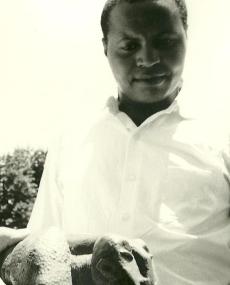
Sydney Alex Kumalo was born in the middle of the colonial conquest of Africa, the same year that Benito Mussolini’s foreign armies invaded Abyssinia (later called Ethiopia), which was under Emperor Haile Silassie. The sculptor and painter, was born on 13 April 1935 in Sophiatown, Johannesburg. He often accompanied his father, a house painter to work. During this time, the Black societies in South Africa were challenged by modernity and urbanity, which merged with racial segregation. Kumalo went to school at Madibane High in Diepkloof, Soweto after Black people were forcefully removed from Sophiatown. He attended the Polly Street Art Centre consistently over 4 years between 1953 and 1957. At the Centre, Cecil Skotnes, the Recreation Officer of the Johannesburg city municipality, provided him with mentorship. The gallery owner, Egon Guenther visited the Polly Street Art Centre occasionally to encourage the artists who worked there. He often showed them images of sculptures and drawings of the German Ernest Barlach and Käthe Kollwitz, which acted as references of stylised representations in Kumalo’s work. Between the years 1958 to 1960, Skotnes arranged for Kumalo to build his sculptural works by offering him a space in Eduardo Villa’s studio two times a week.
In 1957, a 22-year-old Kumalo got his first of the many commissions through Skotnes to decorate a church near Kroonstad in the Free State Province. The same year he was favoured to assist Skotnes as an art instructor at the Polly Street Art Centre. He was subsequently appointed to teach on a full time basis from 1959 and continued in the same position at Bantu Men’s Social Club in Eloff Street, (also known as Jubilee Social Centre) upon the closure of the Polly Street Art Centre. As an art instructor he was instrumental in shaping a generation of Black South African artists who studied under his guidance during this period.
Kumalo’s thinking espoused the philosophy of the earlier mission-trained Black individuals who came to be called the New Africans. The personalities organised themselves into units such as labour unions and other professional bodies that strived to acknowledge the humanness of Black people within their limiting environment. Some of the New Africans wrote newspaper columns and books that focused on the development of Black people. Generally, they attempted to participate as equal partners in the new way of life that was characterised by European modernity. In the tradition of the New Africans, Kumalo’s teaching methods, seen through his art, showed awareness of ancient African imagery that he fused with European outlook and forms.
In 1961 he co-founded the art group Amadlozi, which was made up of Ezrom Legae,Cecil Sash, Giuseppe Cattaneo, Skotnes and Villa. Kumalo became a full time artist when he stopped teaching at Jubilee Social Centre in 1964. He was often given commission jobs locally and in neighboring countries. He continued to work and collaborate with Skotnes.
Kumalo held his first solo exhibition at the Egon Guenther Gallery in 1962 and his work inspired some of his art students. His work can be found in the collections of Durban Art Museum, Johannesburg Art Gallery and the University of the Witwatersrand amongst others. His awards range from the 1960 Artists of Fame and Promise to South African Race Relations in 1981. Kumalo’s work was widely exhibited globally and continues to be shown now. He died in 1988 at Chris Hani Baragwanath Hospital in Soweto.